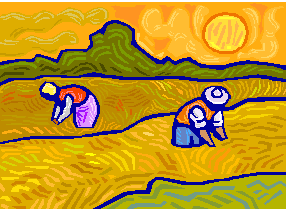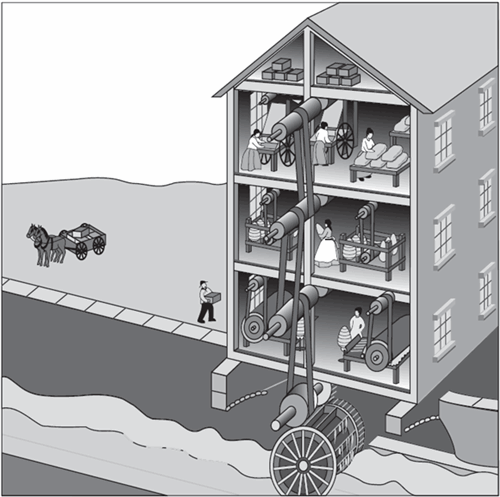
History 1700 MacKay
Economic Systems in the U.S. 1600s to the Civil War (1860s)

Readings:
We will consider the following:
Economic Systems
|
Social changes in response to economic systems
|
Slavery in a capitalist economy
|
Economic systems: Subsistence Mercantilism Capitalism Communitarianism
Subsistence Economy- the products are made not for sale but for consumption inside of economically closed producing unit (the family, the community); it is opposite the market economy, where the products of work are intended for sale in the market.
http://college.hmco.com/history/readerscomp/naind/html/na_017000_iwrel1776.htm#indian04.jpg
Mercantilism: From the 15th to the 18th century, when the modern nation-state was being born, mercantilism developed as an economic system based on:
Mercantilism is an economic system which works to increase a nation's wealth by government regulation of all of the nation's commercial interests.
Mercantilism is the idea that colonies existed for the benefit of the Mother Country. In other words, the American colonists could be compared to tenants. Another facet of mercantilism was the idea that the wealth of the world was fixed. The most important thing for Britain to do was keep its money and not trade with other countries to get necessary items. The colonists role was to provide many of these items to the British.
http://www.maps.com/reference/history/whistory/hw_euroempires.html

The Enslavement of Africans by Europeans and their forced migration to the Americas = a dynamic of mercantilism:
According to European colonial officials, the abundant land they had "discovered" in the Americas was useless without sufficient labor to exploit it. Slavery systems of labor exploitation were preferred, but neither European nor Native American sources proved adequate to the task.
The trans-Saharan slave trade had long supplied enslaved African labor to work on sugar plantations in the Mediterranean alongside white slaves from Russia and the Balkans. This same trade also sent as many as 10,000 slaves a year to serve owners in North Africa, the Middle East, and the Iberian Peninsula.
Having proved themselves competent workers in Europe and on nascent sugar plantations on the Madeira and Canary Islands off the coast of Africa, enslaved Africans became the labor force of choice in the Western Hemisphere—so much so that they became the overwhelming majority of the colonial populations of the Americas.
Of the 6.5 million immigrants who survived the crossing of the Atlantic and settled in the Western Hemisphere between 1492 and 1776, only 1 million were Europeans. The remaining 5.5 million were African. An average of 80 percent of these enslaved Africans—men, women, and children—were employed, mostly as field-workers. Women as well as children worked in some capacity. Only very young children (under six), the elderly, the sick, and the infirm escaped the day-to-day work routine.
More than half of the enslaved African captives in the Americas were employed on sugar plantations. Sugar developed into the leading slave-produced commodity in the Americas. http://news.nationalgeographic.com/news/2003/01/0131_030203_jubilee2.html
The Persistence of Southern Slavery in the 19th century is the Result of:
The Profitability of Slavery in the U.S.
Diverging Cultures: North & South
The Triangular trade:
Source: http://members.tripod.com/lylesj/trade/tritrade.html
Capitalist Economy- From the 18th century to the present. Capitalism is based on the same principle as mercantilism: the large-scale realization of a profit by acquiring goods for lower prices than one sells them. But capitalism as a practice is characterized by the following:
White Middle class changes in family and gender roles
A woodcut printed in The Little Book of Early American Crafts and Trades (first published in 1807) illustrates the family economy at work in the home.
- The Henry Ford Museum has a virtual tour forK-8 students which shows a subsistence economy: Meet the Daggetts
The
Four Seasons of Life--Middle Age: The Season of Strength
Currier & Ives, 1868
In the pre-industrial household all members of the family were required to be productive to ensure the well being of the family. Although there were specific roles played by men, women and children, all played some role and all needed the others. With industrial, factory production it was increasingly common for one or two members of the family to be the ones to go out to work and bring home the money required to support the others.
In the early years of factory production it was not at all clear that it was the men that should be the wage earners. In fact the industrialists were happy to fill their factories with children and particularly women. Many industrialists argued women were better workers than men. A social and economic battle was fought in the early 19th century the outcome of which was the definition of men as the primary wage earners. This battle was accompanied by a redefinition of gender roles to comply with the above public/private separation of life.
Men came to be associated with the public sphere and women with the private or domestic. Interestingly as this happened, the definition of what it meant to be a man and what it meant to be a woman began to change. Men needed to function in the public sphere which was seen as cold and uncaring and harsh. Men came to be defined according to this environment and needed to be tempered and softened by the domestic sphere which was warm, accepting and nurturing. Women were viewed as being especially outfitted to provide this kind of environment for their children and men. Thus women were redefined as essentially moral and religious but also soft and vulnerable and needing the protection of their publicly oriented men. This view of men and women was invented by the 19th century middle class and became so influential by the twentieth century that it seemed like this the way it had always been.
Differences between subsistence and capitalist economic systems:
Subsistence Production Commercial Production
- for use-value
- limited in quantity
- community based
- directed towards self-sufficiency and sustainability
- for exchange-value
- open-ended
- individualistic
- directed for capital accumulation
Cultural changes as part of developing market economy:
- Demographic pressures
- Widespread geographic mobility
- Rapid environmental change
- Government support of markets/business
--"transportation revolution"- Market expansion: geographic & substantive
- Reorganization of work
- Reorganization of the family/ gender roles
For further in information about capitalism http://www.rationalrevolution.net/articles/capitalism_economy.htm
 Textile
mill from 1830.
Textile
mill from 1830.
Communitarianism is an economic system which emphasizes community over individualism. Active communities support their own members, engage in 'moral dialogues' that define and redefine important values, and enforce community standards through the weight of a shared moral culture.
 (http://richfieldogdens.blogspot.com/)
(http://richfieldogdens.blogspot.com/)